Introduction
Branding is a critical component of any company’s success, regardless of its size. As a leading marketing agency, Cool Nerds Marketing understands the value of effective branding in establishing a unique identity and fostering a strong connection with the target audience. In this comprehensive guide, we will delve into the step-by-step process of branding and explore the integral role marketing plays in creating, promoting, and enhancing a brand’s presence.
H1: Step 1 – Defining Your Brand Identity
H2: 1.1. Understand Your Company’s Vision and Values
The first step in the branding process is to gain a deep understanding of your company’s vision and values. What is your purpose? What do you stand for? By clarifying your core values, you can build a brand that aligns with your long-term business goals and resonates with your target audience.
H2: 1.2. Identify Your Target Audience
Thoroughly researching and identifying your target audience is crucial for successful branding. Understand their preferences, needs, and pain points. This insight allows you to create a brand that speaks directly to your audience, making it easier to establish an emotional connection.
H2: 1.3. Develop a Unique Brand Personality
Your brand’s personality plays a significant role in shaping customer perceptions. Consider the traits you want your brand to exude – whether it’s fun and playful, innovative and modern, reliable and trustworthy, or authoritative and knowledgeable. Consistency in brand personality across all touchpoints helps solidify your brand’s identity in the minds of consumers.
H1: Step 2 – Crafting Your Brand Elements
H2: 2.1. Brand Name and Tagline
Choosing a memorable and meaningful brand name is crucial. It should be easy to pronounce, spell, and reflect your brand’s identity. A compelling tagline can further enhance your brand’s message and succinctly communicate your unique selling proposition (USP).
H2: 2.2. Logo Design
Your logo is the visual representation of your brand. It should be simple, versatile, and instantly recognizable. Invest in professional logo design that aligns with your brand’s personality and leaves a lasting impression on your audience.
H2: 2.3. Color Palette and Typography
Colors evoke emotions and play a significant role in brand recognition. Select a consistent color palette that complements your brand personality and resonates with your target audience. Additionally, choose typography that complements your brand’s voice and conveys the desired tone.
H2: 2.4. Brand Voice and Tone
Defining your brand’s voice and tone is essential for consistent communication. Whether your brand speaks in a formal, friendly, or conversational manner, ensure this tone is reflected in all your marketing efforts. A consistent voice helps build familiarity and trust with your audience.
H1: Step 3 – Brand Integration in Marketing
H2: 3.1. Consistent Messaging
Branding and marketing go hand in hand when it comes to messaging. Consistency in your brand messaging across all marketing channels, including your website, social media, email campaigns, and advertisements, reinforces your brand’s identity and value proposition.
H2: 3.2. Content Marketing
Content marketing is a powerful tool for brand positioning. Create valuable, informative, and engaging content that aligns with your brand identity and addresses your target audience’s pain points. By providing valuable content, you position your brand as an authority in your industry, fostering trust and loyalty.
H2: 3.3. Social Media Strategy
Social media platforms like Facebook or tik tok are invaluable for brand promotion and engagement. Incorporate your brand’s personality into your social media presence. Interact with your audience, share content that resonates with them, and respond to customer queries and concerns promptly. Social media allows you to create a more personalized and authentic connection with your customers.
H2: 3.4. Influencer Marketing
Influencer marketing is an effective way to extend your brand’s reach. Collaborate with influencers whose values align with your brand’s identity. By leveraging their influence, you can tap into new audiences and build credibility and trust with potential customers.
H2: 3.5. Brand Partnerships
Consider strategic brand partnerships to amplify your brand’s presence. Collaborate with other brands or organizations that share similar values. Co-branded campaigns can help increase brand visibility and attract a broader audience.
H1: Step 4 – Monitoring and Adaptation
H2: 4.1. Track Brand Metrics
Regularly monitor brand metrics such as brand awareness, brand perception, customer loyalty, and brand sentiment. Analyzing these metrics provides valuable insights into the effectiveness of your branding efforts. Based on the data, adjust your strategies to better resonate with your target audience.
H2: 4.2. Customer Feedback
Customer feedback is a goldmine of information about your brand’s performance. Encourage customers to provide feedback and reviews, and actively listen to their opinions. Address any issues promptly, and use feedback to improve your brand’s offerings and customer experience.
H2: 4.3. Adapt to Market Changes
Branding is an ongoing process, and market dynamics can shift quickly. Stay agile and be prepared to adapt your branding strategies to remain relevant and appealing to your target audience. Monitor industry trends and consumer behavior to ensure your brand remains competitive.
Conclusion
In conclusion, branding is a dynamic and intricate process that requires meticulous planning, creativity, and consistent execution. By defining your brand identity, crafting compelling brand elements, integrating branding into your marketing strategies, and continuously monitoring and adapting, you can establish a powerful and enduring brand presence.
As an experienced marketing agency, Cool Nerds Marketing recognizes the integral role of marketing in every step of the branding process. Through effective messaging, content marketing, social media strategy, influencer marketing, brand partnerships, and comprehensive monitoring, marketing amplifies the reach and impact of your brand.
By following this step-by-step guide and leveraging marketing strategies, your company, whether small or large, can build a strong brand that leaves a lasting impression and creates a loyal customer base. Embrace the power of branding and marketing to unlock new opportunities and solidify your position in the market.





